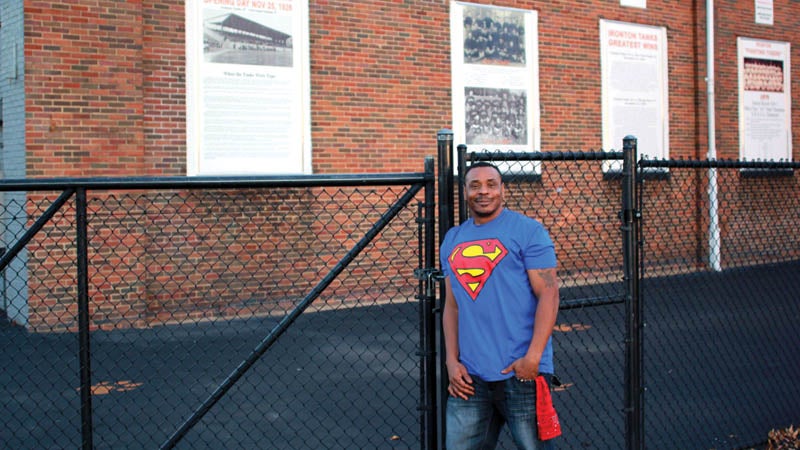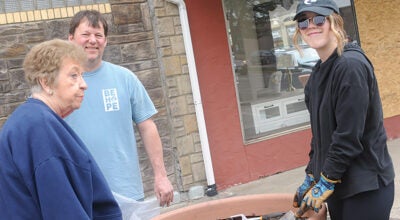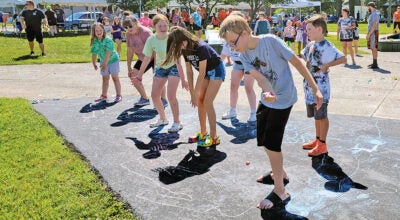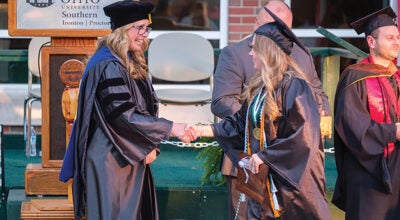Finding Bobby Brice
Published 9:32 am Saturday, October 6, 2018

- Former Ironton High School football player Bobby Brice outside of the field he ruled with his athleticism in the 1980s.
Catching up with Ironton’s football great
I pressed the side of my forehead to the passenger seat window of my grandfather’s pickup truck, watching the wooden posts on the guardrail fly by as we drove into town. It was a Saturday morning, probably 8 a.m., and we were on our way to the local hangout spot for retired vets, McDonald’s.
A group of seven or eight of them would sit down to enjoy their complementary senior coffee, gossip about local politics and talk about the simpler times when the factories in our town were still open and you could get a job straight out of high school.
I would occasionally accompany my grandfather in hopes of being treated with pancakes for breakfast. The usual background noise of elderly men swapping war stories continued as I began to lose interest in the toy from my Happy Meal. Bored, I tugged on my grandfather’s shirtsleeve.
“Pawpaw,” I said, “Who was the best football player to come through Ironton?”
This was not a simple question. My hometown was known for two things: steel and football.
A debate sparked, and names of young men from Ironton who became NFL greats like George McAfee and Coy Bacon were being thrown into the discussion.
Then, a hush came over the group of otherwise boisterous men as one man whispered, “Bobby Brice.” This was the first time I heard his name, but it would not be the last.
My hometown, Ironton, is nestled on the banks of the Ohio River, bordering Kentucky and West Virginia. Like many small towns in Ohio it was built on the backs of the steel industry, and when steel died, so did some of the town. The way people escaped was through football.
It wasn’t the star-studded football seen on Sundays, or even the major college football seen on Saturdays, but a football of a different variety. In this town, nameless jerseys are worshiped on Friday nights and kids dream of scoring the winning touchdown in the state championship game, rather than the Super Bowl.
Who is Bobby Brice?
The attitude amongst those in the town was an unspoken one, “that at least we have Ironton High School Football,” and for the 1987 season it was “At least we have Bobby Brice.”
Bobby Brice was like a lightening bolt that struck Ironton, and then vanished into the fall air.
He was a ghost to people from my generation, unseen and known only through stories passed down through the years: throwing a no hitter, while pitching four innings with his left hand and five with his right; outrunning the 100-meter champion while barefoot. The stories only fueled the mythology.
Ironton barely knew his name until one night, in late 1986. Ironton High School was hosting Cincinnati CAPE at Tanks Memorial Stadium for the AP state championship. CAPE was ranked first and Ironton second. CAPE had two of the top players in the country in Ohio’s “Mr. Football” running back Carlos Snow and defensive back Vinnie Clark. People started filling the stadium hours before kickoff.
CAPE started fast, jumping out to a 14-0 lead in the second quarter, when a loud rattling sound came from above. Out of nowhere, a helicopter appeared. It circled the stadium before landing on the lawn of Central Christian Church, adjacent to the stadium. Out stepped the head coach of The Ohio State University, Earle Bruce. He had come to see Snow and Clark.
His attention, however, was soon diverted.
Just before halftime CAPE’s quarterback dropped back and threw a long pass down field to what he thought was an open man. Ironton’s #24 stepped in front of the receiver for the interception. Ironton then drove to CAPE’s 9-yard line. Ironton’s quarterback rolled out to find that same #24 open in the end zone for a touchdown. A legend was slowly being born.
When the second half opened #24 had now moved from tight end to half back and it was his number Ironton’s quarterback called after a long kick return. The play was an off-tackle run to the right and at the snap Clark was waiting for him to make the tackle. Bobby Brice sprinted directly at Clark and, with one single move made, the future NFL Pro-Bowler fell to the ground as he sprinted 35 yards to the end zone. Brice had touched the ball three times in the game, two of them were touchdowns, and the other was an interception.
Ironton went on to win the game 21-14, winning the AP State Championship, and catapulting Bobby Brice into stardom. “It was crazy,” recalled Jermon Jackson, who later starred for Ironton but was in the stands that day. “Coach Bruce came to see Carlos Snow and Vinnie Clark, but he ended up watching Bobby.”
This game led to the 1987 season where Bobby would rush for over 1,000 yards and 25 touchdowns. Stores were shutting down on Friday nights so people could go see him play. Lines outside the stadium stretched for three or four blocks and extra bleachers were added.
Jermon Jackson was still a child that season, but could recall thinking, “It was like seeing God walk down the street in an Ironton letterman jacket.”
Who’s recruiting you?
Bobby Brice, now a legend, graduated that spring. He was going nowhere.
It is impossible to fully understand what Bobby was going through that year without having lived it yourself. I did. Twenty years after Bobby’s remarkable senior year, I was the quarterback of Ironton’s county rival, Rock Hill High School. To be a high school football star in my town was a great thing, but also a burden — having on your shoulders the weight of a community expecting you to make it out.
Every fall, people would walk up to me and ask “How are we going to do this year?’ Or “Where are you going to play in college?” And “Whose recruiting you?” You have to perform.
You have to make it or you will have failed them.
Bobby Brice got no major college offers – not from Michigan, where he wanted to go, not from Ohio State, whose coach had seen him outplay those future professional stars. Talent was not the issue. The issues were far more complicated, as I was soon to learn.
Meeting Bobby Brice
I did not know what to expect when I finally tracked down Bobby Brice. It turned out he was living nearby, just across the Ohio River in Catlettsburg, Kentucky, but had agreed to meet me at my brother-in-law’s house in Ironton.
I was nervous as I walked up the stairs. I was finally going to meet a man I had only heard about in ghost stories from my childhood. I did not know what to expect. Was this going to be a person who was beaten down, worn out by life? Would he be closed off and unwilling to answer questions? I got to the top of the stairs, and was greeted with a hug from by my brother-in-law, and then I saw Bobby.
“Hi,” he said, “My name is Bob.”
And then he shook my hand. He was tall and broad shouldered. Bobby Brice still looked like Bobby Brice.
We sat down and began to talk. The kid in me was dying to know so much, so the first question I blurted out was, “Is it true that you pitched a no-hitter using both your right and left hands?”
A huge laugh erupted out of Bobby, “Yeah, yeah, that’s true,” he said. “But that was down at the Boys and Girls Club. I couldn’t get away with that in the tougher leagues.”
He would throw left handed in the Boys and Girls Club league to work on his skills, while his dominant hand was actually his right. That day, he got fed up with throwing left handed, and switched his glove over to his right.
Bobby explained that baseball was probably his best sport growing up, and his dad always worked with him. This was the beginning of his journey in sports, and that’s really the only thing that was consistent about his early life. Bobby grew up between Ironton, Columbus and Pontiac, Michigan. He was constantly bouncing from his dad’s to his uncle’s to his grandmother’s. Sports were the only source of stability in his life.
His dad would drive him nearly six hours every Friday morning in the fall to go see the Ironton games on Friday nights. Even as other grade schoolers would be playing football games of their own on Fridays, Bobby would be at the stadium, sitting as close as he could to the field, watching the running backs’ every move.
“All I ever wanted to be was the greatest football player Ironton had ever seen,” he said.
Stumbling Blocks
The problem for Bobby, like Ironton, was not on the field. Growing up meant constant moving and an inconsistent school life. By the time he got to high school, he was placed in vocational classes – not the classes meant for students going to college.
“To me this was a signal that I was there to play football,” he said, “and that was it.”
The constant motion that was Brice’s life also hindered the coaches at Ironton from not seeing him play until his junior year, in 1986. Starting only one year at halfback meant college colleges saw him only after they had awarded most of their scholarships; the vast majority are given in a player’s junior year. Bobby had to settle for a scholarship at Central State, an NAIA school outside Dayton.
His time at Central State was short lived. That summer, he moved up the depth chart, ever closer to starting. But he was not happy. He recalls the poor quality of the cleats he was first issued, and how the shoes improved as his status grew. But there was something missing: he had the lost the will to compete. He left school in the middle of one night thinking he would never play football again.
He went back to the place where his grandmother lived — the woman, he says, he loved more than words could explain — to the place where he learned to kick field goals over a swing set, where he would play basketball on the corner of Ninth and Madison streets, the only place he knew as home, Ironton.
For the next few years he worked for an RC Cola distributor, but football was always in the back of his mind, and one day he got a call. It was Coach Tom Lichtenberg, the head coach of Ohio University. Lichtenberg was on Earle Bruce’s staff at Ohio State in 1986, and had also flown to Ironton for the championship game. He had seen Bobby play and now he had found him. Bobby was going to play football again.
At this point, Bobby weighed about 265 pounds, and was not even close to being in playing shape. He went into pre-season camp, not knowing what to expect, or whether he could still play as he used to. The first practice had ended, and the team was working on conditioning. Bobby knew he could prove to not only the coaches, but himself, that he still could run with the best.
Ray Leonard Jr., the son of boxing legend Sugar Ray Leonard, was the team’s exceptionally fast wide receiver. Bobby lined up next to him for a 50-yard sprint, eager to prove a point.
The whistle blew. Bobby sprinted with keeping his head down and digging his shoes into the turf. As he approached the goal line he looked to his left and leaned forward. They crossed at the same time. Even at 265 pounds, Bobby had speed few could match.
“What happened?” I asked.
Bobby spent most of his time at Ohio as a backup running back, trying to make his way into the starting line-up. He was taking classes and playing ball, while living with his then wife, Katrina, and toddler son, Major.
Slim to none
Things seemed like they were starting to work out. It was spring, and Ohio University was in the midst of their first spring practice when Katrina urgently ran onto the field to talk to Bobby. “It’s Major,” she said, with tears running down her face. He had gotten into some medication in Katrina’s purse and taken the pills. He and Katrina rushed him to the hospital, and luckily, made it in time to save him.
Bobby tells me he began to question the importance of football. He met with Lichtenberg and asked him, “Coach, what are the odds of a 23-year-old running back that took four years off to make it to the NFL?”
“Slim to none,” he recalls Lichtenberg replying.
Bobby packed his bags and moved his family back to Ironton, but this time it was different.
He was now 24 years old, with a family and no job. The prospects of making a living had always been tough in Ironton, but now they were even worse. There was no Dayton Malleable Iron Company, there was no coke plant or cement factory, or anything. The days of moving to Ironton to find work were over.
Bobby and his family bounced from house to house seeking shelter with friends and family, and, some nights, had no place to stay. Bobby says he would scrounge whatever money he could find working odd jobs, like painting houses or cutting grass.
This became the norm, until one day Bobby had had enough. He dropped to his knees and made a promise that his family would no longer struggle. This is when he began dealing crack.
Dealing drugs
Drug dealing in that corner of Ohio, Kentucky, and West Virginia was a lucrative business.
Bobby told me he was always quiet about his dealings. He never wanted trouble; he never wanted violence. This was a means to an end. He continued dealing drugs for several years, until one day he realized what he was doing.
“Seeing someone dig through the carpet of your house to try and find crack will change your outlook on it,” Bobby said. “I wanted out of the game.”
But that realization came too late. The morning, after he promised himself he would quit dealing, he says, he heard a knock on his door.
“I went to go answer the door, and I realized it was the police,” he said. He bolted toward the back door only to find two more officers standing there. “They were even at my bathroom window.”
Bobby walked to the front door, where an officer arrested him for possession of narcotics with intent to sell.
He served three years, but was later arrested, convicted and sentenced to another three-year term for dealing.
God’s plan
He says he turned to religion in prison. He says he began to read his Bible frequently, and find solace in the words on the page.
“The first time I went to prison I didn’t fully understand what God’s plan for me was,” he said. “You’ve got to cast a sword in the fire to make it stronger, and that is exactly what God was doing with me.”
Bobby Brice is a middle aged, ex-con working at an Italian restaurant across the river from Ironton, in Ashland, Kentucky. His marriage ended and he lives with his girlfriend of 15 years. He is close with his son, who played football at Ironton.
We walked outside, roaming the streets where he grew up. He pointed out his grandmother’s apartment on Ninth Street. I suggested we drive to Tanks Memorial Stadium, where crowds of people used to cheer his name. Outside the stadium was “Tiger Alley,” a walkway lined with team photos and banners of Ironton’s great teams.
The alley was locked and I had to lean over the fence to find the photo of the 1986 team, Bobby’s team. Bobby leaned against the fence, which secluded him from the field he used to own, thinking of what once was and what might have been.
Will McCollister is an Ironton resident and a freelance writer whose work has appeared in Sports Illustrated





